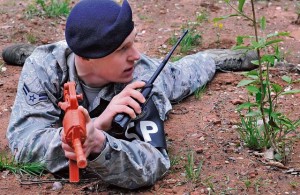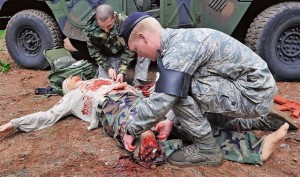
Members of the 569th U.S. Forces Police Squadron and the 86th Medical Group participated in medical training with new mannequins May 30 on Ramstein.
The new mannequins offer first responders a wider variety of training because they speak, lose blood and can move. The training gave security forces members the ability to practice life-saving techniques and gave medics the opportunity to train in a realistic combat situation.
“We simulated a convoy style (improvised explosive device) blast so we could get training for the cops and medics,” said Master Sgt. Jose Loureiro,
86th MDG NCOIC of education and training. “We wanted to get as many people together to benefit from this training. It’s good to get the hands-on training.”
Completing this training gave participants an opportunity to complete an annual training requirement as well.
“This scenario gave us another chance to do our self-aid buddy care training,” said Senior Airman James Hensley, 569th USFPS patrolman. “The training was extremely realistic. The mannequin would shake or talk when you put a tourniquet on, but that’s how we knew it was alive.”
The scenario allowed Airmen who normally don’t get to train together an opportunity to learn how other units operate.
“Now that we have the simulation technology, doing joint training will be easier,” Loureiro said. “We had medics who haven’t had the opportunity to be involved in a realistic combat training exercise or the chance to get out there and see what it’s like to be under
simulated live fire. We’re building partnerships and we’re learning how other units complete their mission.”

With the new technology, the mannequins are less likely to be damaged due to weather.
“The dummies can be utilized in mud or rain; they’re designed for this kind of weather and terrain,” Loureiro said. “We have control over them. Some can breathe, have arterial bleeds, talk and move. They give members a sense of urgency during their training.”
The lifelike nature of the mannequins adds another more realistic element to the training.
“Having this type of training prepares the responders before they deploy,” Loureiro said. “They are already used to seeing the bleeding, so they won’t be taken by surprise when they encounter these scenarios during combat operations.”


